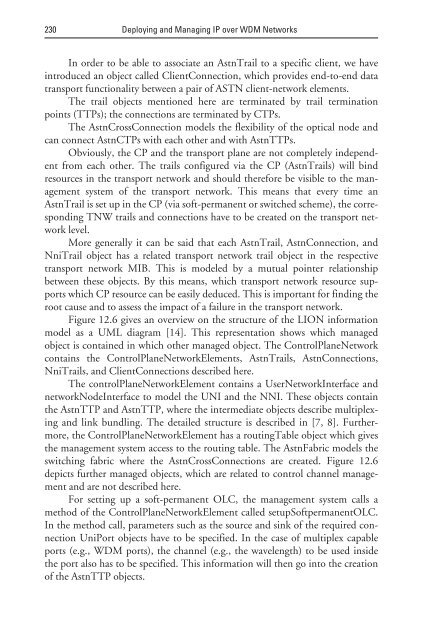deploying and managing ip over wdm networks - Index of
deploying and managing ip over wdm networks - Index of
deploying and managing ip over wdm networks - Index of
You also want an ePaper? Increase the reach of your titles
YUMPU automatically turns print PDFs into web optimized ePapers that Google loves.
230 Deploying <strong>and</strong> Managing IP <strong>over</strong> WDM Networks<br />
In order to be able to associate an AstnTrail to a specific client, we have<br />
introduced an object called ClientConnection, which provides end-to-end data<br />
transport functionality between a pair <strong>of</strong> ASTN client-network elements.<br />
The trail objects mentioned here are terminated by trail termination<br />
points (TTPs); the connections are terminated by CTPs.<br />
The AstnCrossConnection models the flexibility <strong>of</strong> the optical node <strong>and</strong><br />
can connect AstnCTPs with each other <strong>and</strong> with AstnTTPs.<br />
Obviously, the CP <strong>and</strong> the transport plane are not completely independent<br />
from each other. The trails configured via the CP (AstnTrails) will bind<br />
resources in the transport network <strong>and</strong> should therefore be visible to the management<br />
system <strong>of</strong> the transport network. This means that every time an<br />
AstnTrail is set up in the CP (via s<strong>of</strong>t-permanent or switched scheme), the corresponding<br />
TNW trails <strong>and</strong> connections have to be created on the transport network<br />
level.<br />
More generally it can be said that each AstnTrail, AstnConnection, <strong>and</strong><br />
NniTrail object has a related transport network trail object in the respective<br />
transport network MIB. This is modeled by a mutual pointer relationsh<strong>ip</strong><br />
between these objects. By this means, which transport network resource supports<br />
which CP resource can be easily deduced. This is important for finding the<br />
root cause <strong>and</strong> to assess the impact <strong>of</strong> a failure in the transport network.<br />
Figure 12.6 gives an <strong>over</strong>view on the structure <strong>of</strong> the LION information<br />
model as a UML diagram [14]. This representation shows which managed<br />
object is contained in which other managed object. The ControlPlaneNetwork<br />
contains the ControlPlaneNetworkElements, AstnTrails, AstnConnections,<br />
NniTrails, <strong>and</strong> ClientConnections described here.<br />
The controlPlaneNetworkElement contains a UserNetworkInterface <strong>and</strong><br />
networkNodeInterface to model the UNI <strong>and</strong> the NNI. These objects contain<br />
the AstnTTP <strong>and</strong> AstnTTP, where the intermediate objects describe mult<strong>ip</strong>lexing<br />
<strong>and</strong> link bundling. The detailed structure is described in [7, 8]. Furthermore,<br />
the ControlPlaneNetworkElement has a routingTable object which gives<br />
the management system access to the routing table. The AstnFabric models the<br />
switching fabric where the AstnCrossConnections are created. Figure 12.6<br />
depicts further managed objects, which are related to control channel management<br />
<strong>and</strong> are not described here.<br />
For setting up a s<strong>of</strong>t-permanent OLC, the management system calls a<br />
method <strong>of</strong> the ControlPlaneNetworkElement called setupS<strong>of</strong>tpermanentOLC.<br />
In the method call, parameters such as the source <strong>and</strong> sink <strong>of</strong> the required connection<br />
UniPort objects have to be specified. In the case <strong>of</strong> mult<strong>ip</strong>lex capable<br />
ports (e.g., WDM ports), the channel (e.g., the wavelength) to be used inside<br />
the port also has to be specified. This information will then go into the creation<br />
<strong>of</strong> the AstnTTP objects.


